Why are Wattage, Lumens, Lux and PAR All Problematic Measurements When Choosing An Aquarium Light?
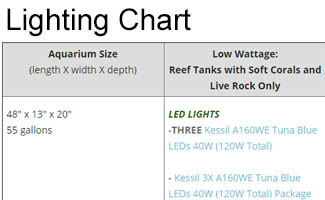
Choosing an aquarium light is a journey down a path littered with confusing terminology. In this article we'll explain this terminology, and we'll also explain why you might be better off just using the MarineAndReef.com
Reef Aquarium Lighting Chart & the MarineAndReef.com
Freshwater Planted Tank and Fish-Only Tank Lighting Chart to determine which light you need.
These Charts make the choice simpler because all you will need to know is what types of organisms you have in your tank and the dimensions of your tank. These Charts are based on years of experience and research and are a much easier way to choose a light that trying to figure how many watts per gallon or lumens or lux you will need.
The following explanation of the terms watts, lumens, lux and PAR will demonstrate why these measures of light are troublesome.
 WATTS = POWER CONSUMPTION
WATTS = POWER CONSUMPTIONWattage, named after inventor James Watt, is a measure of how much power a light fixture uses. It is NOT a measurement of light. It is only a measurement of power consumption.
Some lights use power much more efficiently than other lights.
In years past wattage was used as a general indicator of how bright a light should be in order to support different kinds of corals. The old rule was a reef tank needed a minimum of around 3 watts of light per gallon of aquarium water to support hardy beginner corals.
Because most people are using LED lights, and LEDs are far more efficient than traditional florescent and metal halide lighting in terms of the amount of power it takes to produce a similar level of light, the old wattage rule no longer applies.
With LEDs, as little as 1 watt per gallon is sufficient to support low light demand corals. However, even that measurement is troublesome because there is a wide gap in efficiency between the most and least efficient LED lights.
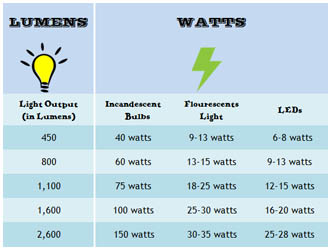 LUMENS = LIGHT PRODUCTION
LUMENS = LIGHT PRODUCTIONThe total lumens produced by a light is a measurement of the total amount of light photons produced by that light source. A fixture’s lumen rating does NOT measure the amount of light at a given space at a given time.
While there may be a lot of lumens produced by a fixture the actual amount of light photons that are projected into the aquarium is different at each individual point in space and is not described by the lumen value attached to a specific light fixture. Some lights project light better than others. For example,
Kessil lights are very good at projecting light deep into an aquarium.
Additionally, when lumens are measured all colors of light wavelengths are counted equally. This is an issue because corals do not use all light wavelengths equally. Some wavelengths they do not use at all. The result is that a light that produces more lumens may actually produce less useable light for corals than another light that produces far fewer lumens.
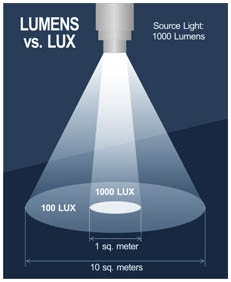 LUX = LUMENS REACHING A PARTICULAR LOCATION
LUX = LUMENS REACHING A PARTICULAR LOCATIONLux is a measurement of light that records the amount of lumens at a particular location at a particular time. This gives a more useful measurement of a light’s performance because it lets you know how much light is actually getting to your particular corals.
However, as with lumens, lux does not take the color of the particular light wavelengths into account. If the color temperatures of the light are not useful for a coral, lux will not be a good measure of useable light. Many reef lights have insufficient near UV lighting for corals.
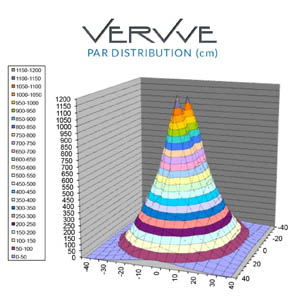 PAR = PHOTONS OF A PARTICULAR LIGHT SPECTRUM HITTING A PARTICULAR LOCATION
PAR = PHOTONS OF A PARTICULAR LIGHT SPECTRUM HITTING A PARTICULAR LOCATIONPAR stands for photosynthetically active radiation. PAR is a measurement of the amount of photons hitting a particular location at a particular time within the range of the light spectrum that is used for photosynthesis. PAR is a much more practical measurement of the amount of light that your corals are actually receiving in comparison to any of the above terms.
With many high end lights the manufacturer will publish a complex PAR chart showing the amount of PAR at various distances from the light.
IS PAR THE BEST WAY TO MEASURE USABLE LIGHT IN AN AQUARIUM?
In a word,
NO. While PAR specifies light in the range that plants can use, photosynthetic plants and corals don’t use the entire light spectrum within the PAR range of 400-700 nano meters evenly. Below is a graph of the absorption peaks of chlorophyll A and B (
the parts of the cell that absorb light energy in photosynthesis).
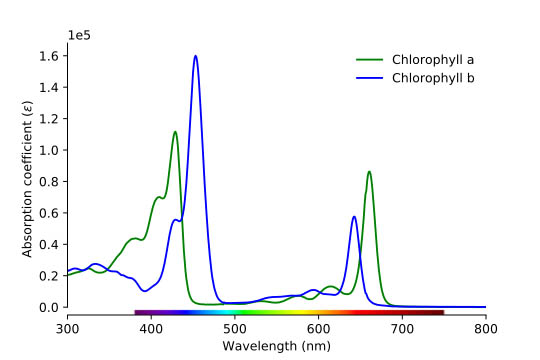
You can see that chlorophyll use the red and blue spectrums far more than the green color in the middle of the graph. You can also see that a large portion of the graph is lower than 400nm. This is UV light. UV light is extremely important for photosynthesis and is not measured by a PAR meter because it is lower than the 400 nm point a PAR meter can read.
Now, look at the graphs below for Kessil's three colors of LED lights.

In these graphs you see the Kessil Tuna Flora replicates the photosynthesis peaks of chlorophyll almost exactly. These lights are great for growing plants. However, they can look a bit unnatural. This is because the sun still produces green light even though plants don’t use it and because water starts to filter out light starting with the lowest energy wavelengths which are the longer wavelengths towards the right of the graph. Because of this the freshwater Tuna Sun lights have reduced red and additional green to look like daylight. The saltwater Tuna Blue still has peaks in the blue and UV range along with a slight bump in the red, but they have reduced the red and green colors further because at ocean depths the water filters out most of the red and green light. Kessil is one of the only lights to have a substantial peak in the UV range and this UV light is not measurable with a PAR meter.
Other companies will state their lights have greater PAR than Kessil lights, but usually this is only because the most important light from a Kessil is not measured by PAR meters.
CONCLUSIONS
As we stated at the beginning, there are no easy answers when it comes to choosing an aquarium light. You need to be weary of claims regarding watts, lumens, lux and PAR. Your best bet is to refer to the
MarineAndReef.com Reef Lighting Chart and the
MarineAndReef.com Freshwater Planted Tank and Fish-Only Tank Lighting Chart. We’ve incorporated many different factors into these charts—from the data provided by the manufacturers, to personal experience with our own tanks and feedback from hundreds of stores, service professionals, researchers and customers.





























 WATTS = POWER CONSUMPTION
WATTS = POWER CONSUMPTION LUMENS = LIGHT PRODUCTION
LUMENS = LIGHT PRODUCTION LUX = LUMENS REACHING A PARTICULAR LOCATION
LUX = LUMENS REACHING A PARTICULAR LOCATION PAR = PHOTONS OF A PARTICULAR LIGHT SPECTRUM HITTING A PARTICULAR LOCATION
PAR = PHOTONS OF A PARTICULAR LIGHT SPECTRUM HITTING A PARTICULAR LOCATION
